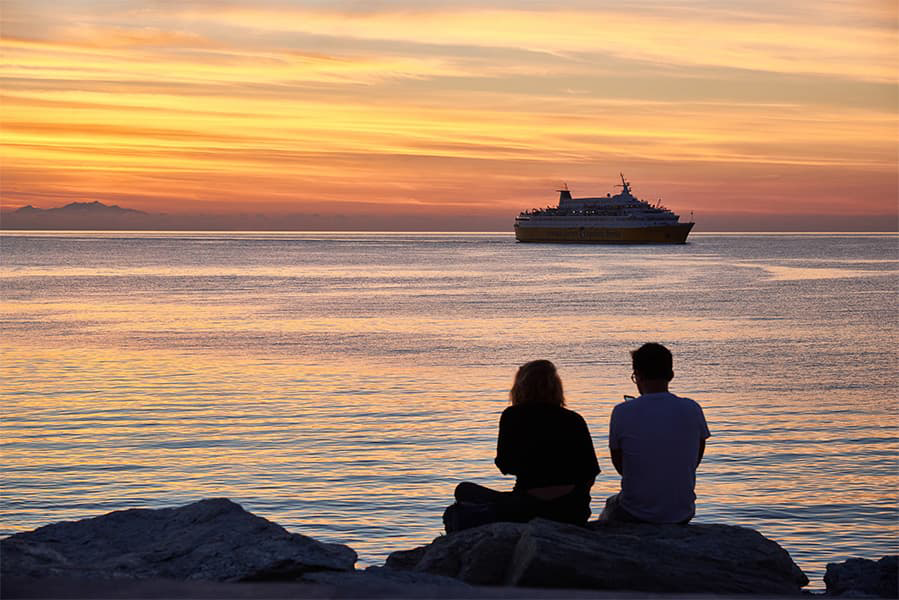Palma - Valencia
Ferries to Spain
Palma - Valencia
Ferries to Spain

The Palma to Valencia ferry route is provided by 3 ferry companies. The ferry crossing from Palma to Valencia is approximately 7 hours 59 minutes on most ferries servicing this route. Ferries between Palma to Valencia cost around $79 and $427, depending on ticket details. Prices exclude any service fees. Ferry timetables change seasonally, use our Deal Finder to get live pricing and availability for ferries from Palma to Valencia.
Palma Valencia ferry sailings typycally depart from Palma at around 10:00. The last ferry leaves at 23:58.
The Palma Valencia ferry trip can take around 7 hours 59 minutes. The fastest Palma to Valencia ferry is around 7 hours 15 minutes. Crossing times can vary between ferry operator and seasons.
There are around 22 weekly sailings from Palma to Valencia serviced by Balearia, Grandi Navi Veloci & Trasmed GLE. Timetables can vary by season and operator.
Palma Valencia ferry prices typically range between $79* and $427*. The average price is typically $181*. The cheapest ferries from Palma to Valencia start from $79*. The average price for a foot passenger is $114*. The average price for a car is $190*.
Ferry price can vary based on booking factors such as number of passengers, vehicle type sailing times. Pricing is taken from searches over last 30 days and exclusive of service fees, last updated December 25.
The distance between Palma to Valencia is approximately 204 miles (328km) or 177 nautical miles.
Yes, Balearia, Grandi Navi Veloci & Trasmed GLE allow cars on board ferries between Palma and Valencia. Use our Deal Finder to get live pricing for car ferries between Palma and Valencia.
Foot passengers can travel on the Palma to Valencia ferry with Balearia, Grandi Navi Veloci & Trasmed GLE.
Pets can travel on ferries from Palma to Valencia with Balearia. Pets may have to stay in the vehicle during the journey depending on the operators guidelines.
More routes than anyone else.

Compare fares, times & routes in one place.
Change plans easily with flexi tickets.

Book e-tickets & manage trips in-app.
Live ship tracking & real-time updates.

Top-rated customer support when you need it.
| Palma - Valencia Ferry Route Summary | ||
|---|---|---|
| Departure Country | Mallorca | |
| Destination Country | Spain | |
| No. of Operators | 3 | |
| Operators | Balearia, Grandi Navi Veloci & Trasmed GLE | |
| Average Price | $181 | |
| Average Daily Sailings | 3 | |
| Average Weekly Sailings | 22 | |
| Average Sailing Duration | 7 h 59 m | |
| Fastest Sailing Duration | 7 h 15 m | |
| First Ferry | 10:00 | |
| Last Ferry | 23:58 | |
| Distance | 177 Nautical Miles | |
* Prices subject to change, pricing is taken from last 30 days, last updated 1 December 2025.
The city of Palma is located on the south coast of the Spanish island of Majorca and is the capital city of the Balearic Islands. The city lies on the Bay of Palma and is surrounded to the north and west by a mountain range, which has been declared a UNESCO World Heritage Site, called the Serra de Tramuntana. The city's history dates back to Roman times when the site of the present day city was an established Roman camp. Over the course of its history, the city has also come under the rule of the Byzantine Empire, the Moors and James I of Aragon.
The city is now very popular with tourists with attractions like La Seu, the city's cathedral. Built on the site of an earlier mosque, construction on the cathedral began in 1229 and was finally completed in 1601. Also in the city is the Parc de la Mer (the Park of the Sea) which is overlooked by the cathedral and is where visitors can relax under a large yellow and blue canopy which provides shade to a row of wooden benches.
Palma Ferry Port is located on the south western side of the city and provides excellent views of the cathedral as ferries depart. The busy port has good connections to major roads leading out of the city. Destinations available from the port include Ibiza, Mahon, Barcelona, Valencia and Denia.
The Spanish city of Valencia is the third largest city in Spain and is characterised by its lovely architecture, both old and new. The city is known for its excellent Mediterranean climate while the region as a whole has many fine beaches and more than 500 km of coastline. The city is famous in the gastronomic world as being the home of paella and has many fine restaurants which includes a large selection of Tapas bars in the Old Quarter, around the Plaza de la Reina. Popular with visitors is the Valencia City of Arts and Science which contains four main attractions: L'Hemisferic Planetarium which as the name suggests is a planetarium but also a cinema; the Palacio de las Artes Reina Sofia which promotes the city's arts scene; the Parque Oceanografico which includes Beluga Whales, Dolphins, Penguins and a range of tropical fish; and the Museo de las Ciencias Principe Felipe which is a museum that focuses on science and interactive technology.
The Port of Valencia has regular passenger services to and from the Balearic Islands and Italy, along with a growing number of visiting cruise ships.